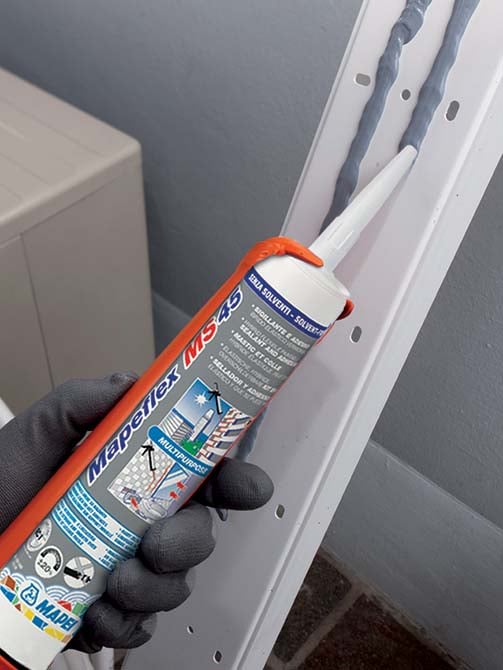Different sealant types: their strengths and areas of use.
Elastic sealants are products that help safeguard the integrity of structures which contain breaks and gaps. These gaps may be there by design, e.g. structural and non-structural joints, or they may be accidental, e.g. fissures or cracks arising from movements and deformations. In structures exposed to the atmosphere, agents such as water, gases, dust, heat and noise are free to enter or escape through these breaks and gaps, thereby harming the durability of the structure and reducing living comfort.
An elastic seal, correctly installed, contributes to the durability, safety and energy efficiency of the entire structure.
No. The elastic sealants available on the market are now made up of various polymers: acrylic, bituminous, butyl, hybrid, polyurethane, and silicone polymers, each with its own specific physical-mechanical characteristics and areas of use.
Which are the best elastic sealants?
No elastic sealant type is necessarily better than another one: each product group has specific physical-mechanical characteristics that make it especially suitable for a particular type of application and less so for another type.

MAPEFLEX MS45 is a flexible sealant for vertical and horizontal joints between different materials, including damp substrates. Once set, it is compatible with elastomeric paints. The same product may also be used as an adhesive to bond building components and features.
For comparative purposes, here are the key strong points of the most common product groups in the elastic sealants category:
Acrylic sealants
• easy to smoothen
• paintable with elastic paints
• low-cost
Acetic silicone sealants
• easy to extrude and smooth off
• resistant to ageing
• resistant to high service temperatures
• resistant to chemicals
• transparent version available (opalescent effect)
Neutral silicone sealants
• easy to extrude and smooth off
• adhere to a wide range of materials
• resistant to ageing
• resistant to high service temperatures
• resistant to chemicals
• transparent version available (translucent effect)
Polyurethane sealants
• adhere to a wide range of materials
• high mechanical and tear resistance
• highly adhesive
• paintable with elastic paints
Hybrid sealants
• easy to extrude and smooth off
• adhere to a wide range of materials, including damp surfaces
• resistant to ageing
• limited surface dust retention
• transparent version available (crystal clear effect)
Epoxy-polyurethane sealants
• easy to extrude and smooth off
• strong and resistant to chemicals
• paintable or pigmentable on site.
Which product can I use to seal and bond different materials?
MAPEFLEX MS45 is a one-component, multi-purpose, flexible sealant for sealing vertical and horizontal joints between different absorbent and non-absorbent materials, including damp substrates. Once set, it is compatible with elastomeric paints from the Mapei range. The same product may also be used as an adhesive to bond building components and features thanks to its high initial grab, rapid-hardening property and adhesive strength.
Which sealant can I use for natural stone floor and wall coverings?
MAPESIL LM is an anti-stain sealant ideal for all types of absorbent and acid-sensitive stones; its chemical composition impedes the migration of liquids between the sealant and substrate, thereby preventing unsightly stains forming along the edges of joints caused by the use of unsuitable sealants. The wide range of colours available, coordinated with Mapei coloured grouts, allows them to be matched with the different colours of the most commonly used types of stone on floors and façades.
Which sealant can I use for ceramic floor and wall coverings?
MAPESIL AC is a coloured sealant specifically designed for forming elastic seals in ceramic floor and wall coverings, bathroom fixtures, shower cabins and windows frames. The quality of the MAPESIL AC pure acetic silicone formulation with Mapei BioBlock technology guarantees the maximum level of durability and performance. The extensive colour range available (40 different shades matching the Mapei coloured grouts) enables the designer’s aesthetic requirements to be met.
Which anti-mould sealant can I use in bathrooms and kitchens?
Sealants which are frequently exposed to dampness are prone to mould and algae attack. Since mould and algae are natural organisms which thrive in warm, damp environments, no sealant is able to resist their formation unless it is specially treated with special biocides which discourage them from taking root. Many products from the MAPESIL range are formulated with biocides, but only MAPESIL AC and MAPESIL LM benefit from BioBlock technology which extends biological protection for a long time, especially when correct, periodic maintenance is carried out on the sealant.
Which sealant can I use for industrial floors?
If a sealant is used on horizontal surfaces subjected to severe mechanical and chemical stresses and loads, it must have the capacity to elastically absorb movements in the joints and be able to resist contact with chemical substances and exposure to mechanical stresses caused by passing heavy goods vehicles. In this case, it is important that the sealant chosen for this specific use provides a balanced mix of elasticity, resistance to chemicals and mechanical strengths: MAPEFLEX E-PU 21 SL, a two-component epoxy-polyurethane sealant, or MAPEFLEX PU35 CR, a one-component polyurethane sealant could be the right solution. Because of the number of factors in play, which depends on the specific area of use of the flooring, a personalised Mapei consultation will be able to identify the most appropriate product for each case.
Which fire-resistant sealant can I use?
In many civil and industrial settings, limiting fire risks is a determining factor when choosing the sealant. Some sealing products are formulated for this purpose, thanks to their particularly effective resistance to fire and their behaviour in the event of fire. If a fire does break out, MAPEFLEX AC-FR 2 acrylic sealant and MAPESIL FR silicone sealant provide high resistance to fire (the ability to delay the passage of flames, smoke and heat through joints) and low reaction to fire (the property to emit only a controlled amount and density of smoke and to limit the formation of incandescent droplets).


